weight AUDI A3 2012 Owner´s Manual
[x] Cancel search | Manufacturer: AUDI, Model Year: 2012, Model line: A3, Model: AUDI A3 2012Pages: 280, PDF Size: 70.11 MB
Page 5 of 280
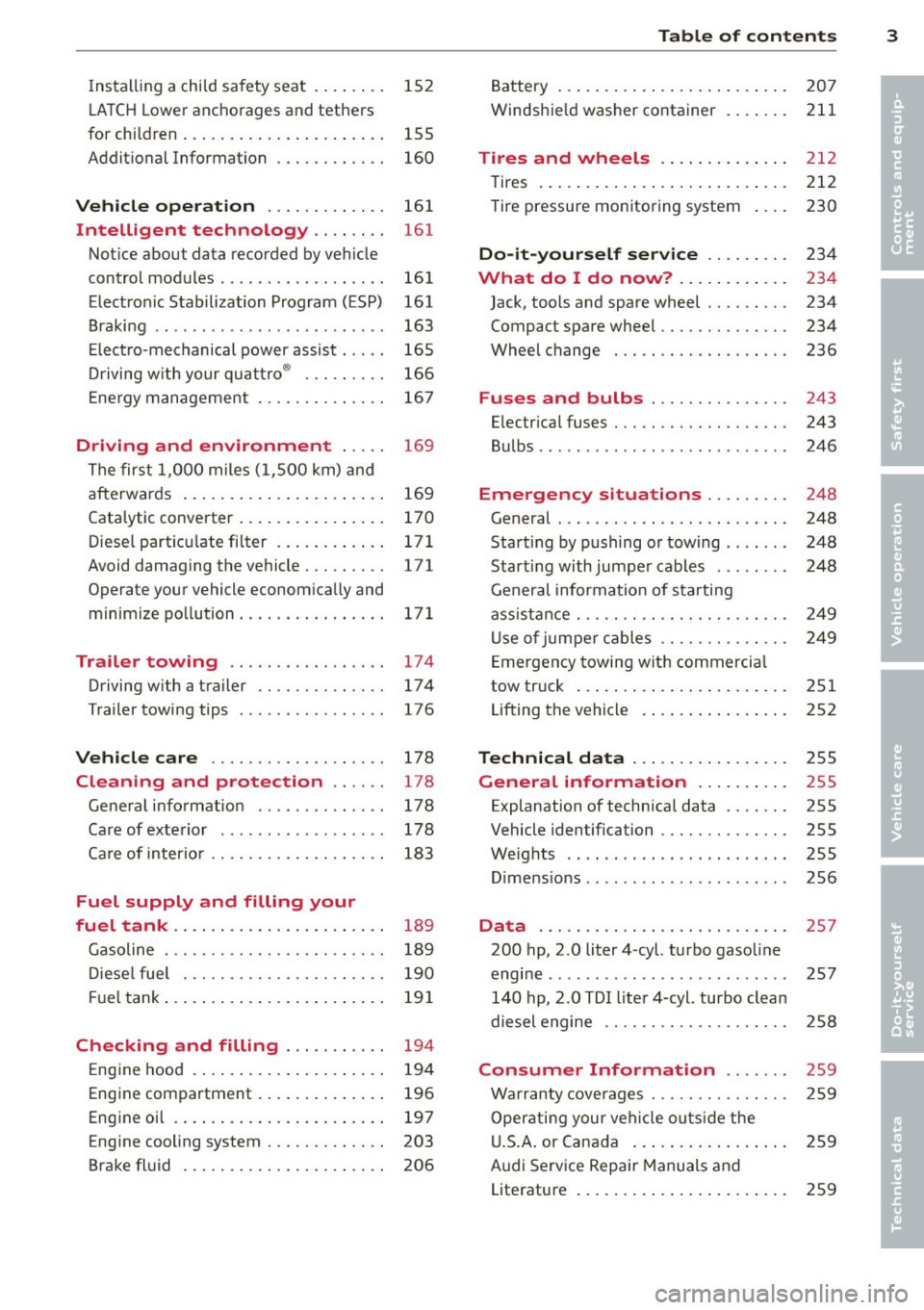
Install ing a chi ld safety seat . ... .. . .
L A T CH Lower anchorages and tethers
for chi ldren ..... ........ ... .. .. . .
Addit ional Information
Vehi cle operat ion ..... .. .. .. . .
Intelligent technology .. .. .. . .
Not ice about data recorded by vehicle
control modules . ...... ... .. .. .. . .
Elect ronic Stabilization P rogram (ESP)
Braking ...... .............. ... . .
E lect ro-mechanical power assist . .. . .
D riving w ith your quattro ® ... .. .. . .
E ne rgy management ...... .. .. .. . .
Driving and environment ... ..
The first 1,000 m iles (1 ,500 km) and
afterwards ..... ...... ... .. .. .. . .
Cata lytic converter ..... ... .. .. .. . .
Diese l particu late fi lter . ... .. .. .. . .
Avoid damaging the vehicle . .. .. .. . .
Operate your vehicle econom ically and
minim ize po llution . ....... .. .. .. . .
Trailer towing ............. .. . .
Driving w ith a trailer ...... .. .. .. . .
Trailer towing tips
Vehi cle care ........... .... .. . .
Cleaning and protection .. . .. .
Ge ne ral i nformation .......... ... .
Care of exte rior . .......... ... ... .
Ca re of inter io r ........... .. .. .. . .
Fuel supply and filling your
152
155
160
16 1
161
161
161
163
165
166
16 7
169
169
170 171
171
171
174
174
176
178
178
178
178
183
fuel tank . . . . . . . . . . . . . . . . . . . . . . . 189
Gasoline . . . . . . . . . . . . . . . . . . . . . . . . 189
D iese l fue l . . . . . . . . . . . . . . . . . . . . . . 190
Fu el tank . . . . . . . . . . . . . . . . . . . . . . . . 191
Checking and filling . . . . . . . . . . . 194
E ng ine hood . . . . . . . . . . . . . . . . . . . . . 194
Engine compartment . . . . . . . . . . . . . . 196
Engine oi l . . . . . . . . . . . . . . . . . . . . . . . 197
Eng ine cooling system . . . . . . . . . . . . . 203
Brake fl uid . . . . . . . . . . . . . . . . . . . . . . 206
Table of contents 3
Battery ... .. .... ... .. .. ..... ... .
Windshie ld washer container
Tires and wheels .... .... ... .. .
Tires ... .. .. .... ... .. .. ..... ... .
Tire pressure monitoring system 207
211
212
212
230
Do-it-yourself service
. . . . . . . . . 234
What do I do now? . . . . . . . . . . . . 234
Jack, tools and spare wheel . . . . . . . . . 234
Compact spare wheel. . . . . . . . . . . . . . 234
Wheel change . . . . . . . . . . . . . . . . . . . 236
Fuses and bulbs . . . . . . . . . . . . . . . 243
E lectr ica l fuses . . . . . . . . . . . . . . . . . . . 243
Bu lbs . . . . . . . . . . . . . . . . . . . . . . . . . . . 246
Emergency situations . . . . . . . . . 248
General . . . . . . . . . . . . . . . . . . . . . . . . . 248
Starting by pushing or towing . . . . . . . 248
Starting with jumpe r cables . . . . . . . . 248
Genera l information of starti ng
ass istance . . . . . . . . . . . . . . . . . . . . . . . 249
U se of j umpe r cables . . . . . . . . . . . . . . 249
Emergency towing wit h commercia l
tow tr uck . . . . . . . . . . . . . . . . . . . . . . . 251
Lifting the vehicle . . . . . . . . . . . . . . . . 252
Technical data . . . . . . . . . . . . . . . . . 255
General information . . . . . . . . . . 255
Explanation of technica l data . . . . . . . 255
Vehicle iden tification . . . . . . . . . . . . . . 255
Weights . . . . . . . . . . . . . . . . . . . . . . . . 255
D.
. 1mens 1ons .. .. .. .. . .. ... ... .. .. . 256
Data . . . . . . . . . . . . . . . . . . . . . . . . . . . 257
200 hp, 2 .0 liter 4 -cyl. turbo gaso line
engi ne ....... ... .. .............. 257
140 hp, 2.0 TOI lite r 4-cyl. turbo cl ean
diesel engine . . . . . . . . . . . . . . . . . . . . 258
Consumer Information . . . . . . . 259
Wa rranty cove rages . . . . . . . . . . . . . . . 259
Operating your ve hicle outs ide the
U .S .A . or Canada . . . . . . . . . . . . . . . . . 259
Audi Se rvice Repair Manuals and
Literature . . . . . . . . . . . . . . . . . . . . . . . 259
•
•
Page 64 of 280
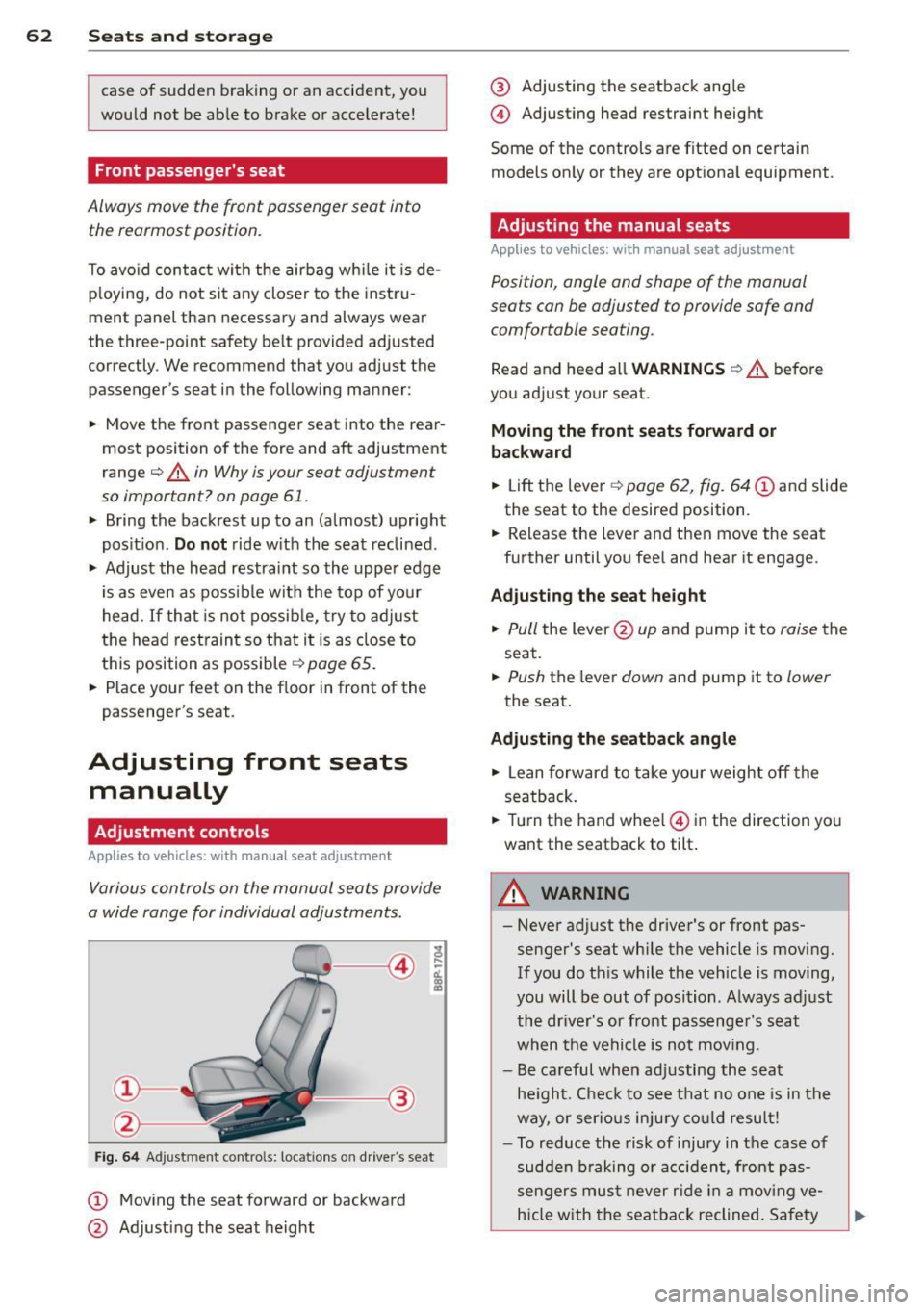
62 Seats and storage
case of sudden braking or an accident, you
would not be ab le to brake or acce lerate!
Front passenger's seat
Always move the front passenger seat into
the rearmost position.
To avo id contact with the airbag wh ile i t is de
p loying, do not sit a ny closer to the inst ru
ment panel than necessary and always wear
the three-point safety be lt provided adjusted
correctly. We recommend that you adjust the passenger's seat in the following manner:
... Move the front passenger seat into the rear
most position of the fore and aft adjustment
range
¢ .&.. in Why is your seat adjustment
so important? on page
61.
... Bring the backrest up to an (almost) upright
pos it ion .
Do not ride w ith the seat reclined.
... Adjust the head restraint so the upper edge
i s as
even as possible with the top of your
head. If that is not possib le, try to adjust
the head rest raint so that it is as close to
t h is position as possible
¢ page 65.
... Place your feet on the f loor in front of the
passenger's seat.
Adjusting front seats manually
Adjustment controls
Applies to vehicles: with manual seat adjustme nt
Various controls on the manual seats provide
a wide range for individual adjus tments.
==""" -®
Fig . 6 4 Ad just ment contro ls: locat ions on drive r"s seat
CD Moving the seat forward or backward
@ Adjusting the seat height
@ Adjusting the seatback ang le
@ Adjusting head restraint height
Some of the co ntrols are fitted on certain
models on ly or they are optiona l equipment.
Adjusting the manual seats
Applies to vehicles: with manual seat adjust ment
Position, angle and shape of the manual
seats can be adjusted to provide safe and
comfortable seating.
Rea d and heed all WARNINGS ¢.&.. befo re
you adjust yo ur seat .
Moving the front seats forward or
backward
"' Lift the leve r¢ page 62, fig. 64 CD and slide
the seat to the desired position .
... Release the lever and then move the seat
further until you feel and hear it engage .
Ad justing the seat height
... Pull the lever @up and pump it to raise the
seat.
... Push the lever down and pump it to lower
the seat.
Adjusting the seatback angle
... Lean forward to take your weight off the
seatback .
... Tur n the hand wheel@ in the di rection yo u
want the seatback to tilt.
A WARNING
- Never adjust the driver's or front pas
senger's seat whi le the vehicle is moving.
If you do th is while the veh icle is moving,
you will be out of position . Always adjust
the dr iver's or front pass enge r's seat
when the vehi cle is not mov ing.
- Be careful when adj usting the seat
he ight. Check to see that no one is in t he
way, or ser io us inju ry co ul d result!
- To reduce the risk of injury in the case of
sudden b raking o r acciden t, front pas
senge rs mus t never r ide in a mov ing
ve
h icle with the seatback reclined . Sa fety
Page 70 of 280
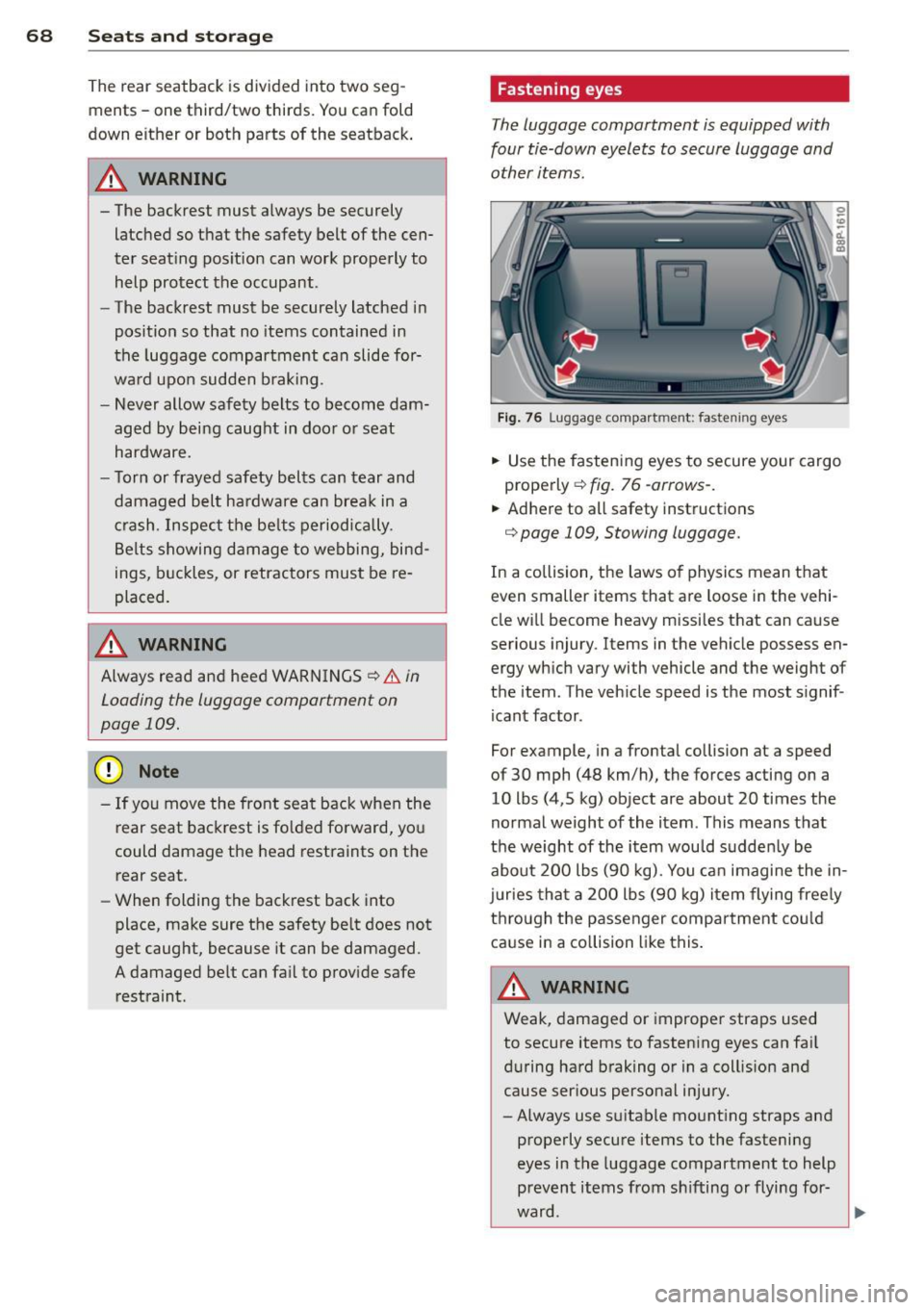
68 Seats and storage
The rear seatback is divided into two seg
ments - one third/two thirds. You can fold
down either or both parts of the seatback .
.&_ WARNING
-
- The backrest must always be securely
latched so that the safety belt of the cen
ter seat ing pos ition can work properly to
help protect the occupant .
- The backrest must be securely latched i n
posit ion so that no items containe .d in
the luggage compartment can slide for
wa rd upo n sudden b rak ing .
- Never allow safety belts to become dam
aged by being caught in doo r or seat
hardware.
- Torn or frayed safety belts can tear and
damaged belt ha rdware can brea k in a
c rash . Inspect the be lts periodica lly .
Belts showing damage to we bbing, bind
ings, b uckles, or retractors must be re
placed.
.&_ WARNING
Always read and heed WA RNINGS c:> .&. in
Loading the luggage comportment on
page 109.
(D Note
- If you move the fro nt seat back when the
r ear seat backrest is fo lded fo rward, yo u
could damage the head restraints on the rear seat.
- When folding the backrest back into
place, make sure the safety be lt does not
get caught, because it can be damaged.
A damaged be lt can fa il to prov ide safe
r est raint.
-
Fastening eyes
The luggage comportment is equipped with
four tie-down eyelets to secure luggage and
other items.
F ig. 7 6 Lugg age compart men t: fas tenin g ey es
.,. Use the fastening eyes to secure your cargo
properly
c:> fig. 76 - arrows -.
.,. Ad here to all safety instructions
<=> page 109, Stowing luggage.
In a co llision, t he laws o f physics mean that
even smaller items that a re loose in the vehi
cle w ill become heavy missiles that can cause
serious injury. Items in the vehicle possess en
ergy wh ich vary with vehicle and t he weight of
the item. The veh icle speed is the most s ignif
icant factor .
For example, in a frontal collision at a speed
of 30 mph (48 km/h), the forces acting on a 10 lbs (4,5 kg) object are about 20 times the
normal weight of the item . This means that
the weight of the item wou ld sudden ly be
about 2 00 lbs (90 kg). You ca n imagine the in
j u ries tha t a 200 lbs (90 kg) item flying free ly
t hr ough the passenger comp artment cou ld
ca use in a co llision like this .
_& WARNING
Weak, damaged or improper straps used
to secure items to fasten ing eyes can fai l
d uring hard braking or in a coll is ion and
cause ser ious personal injury. -
-A lways use s uitable mount ing straps an d
properly secure items to the fasteni ng
eyes in the luggage compartment to help
prevent items from sh ifting or flying for-
~~-~
Page 75 of 280
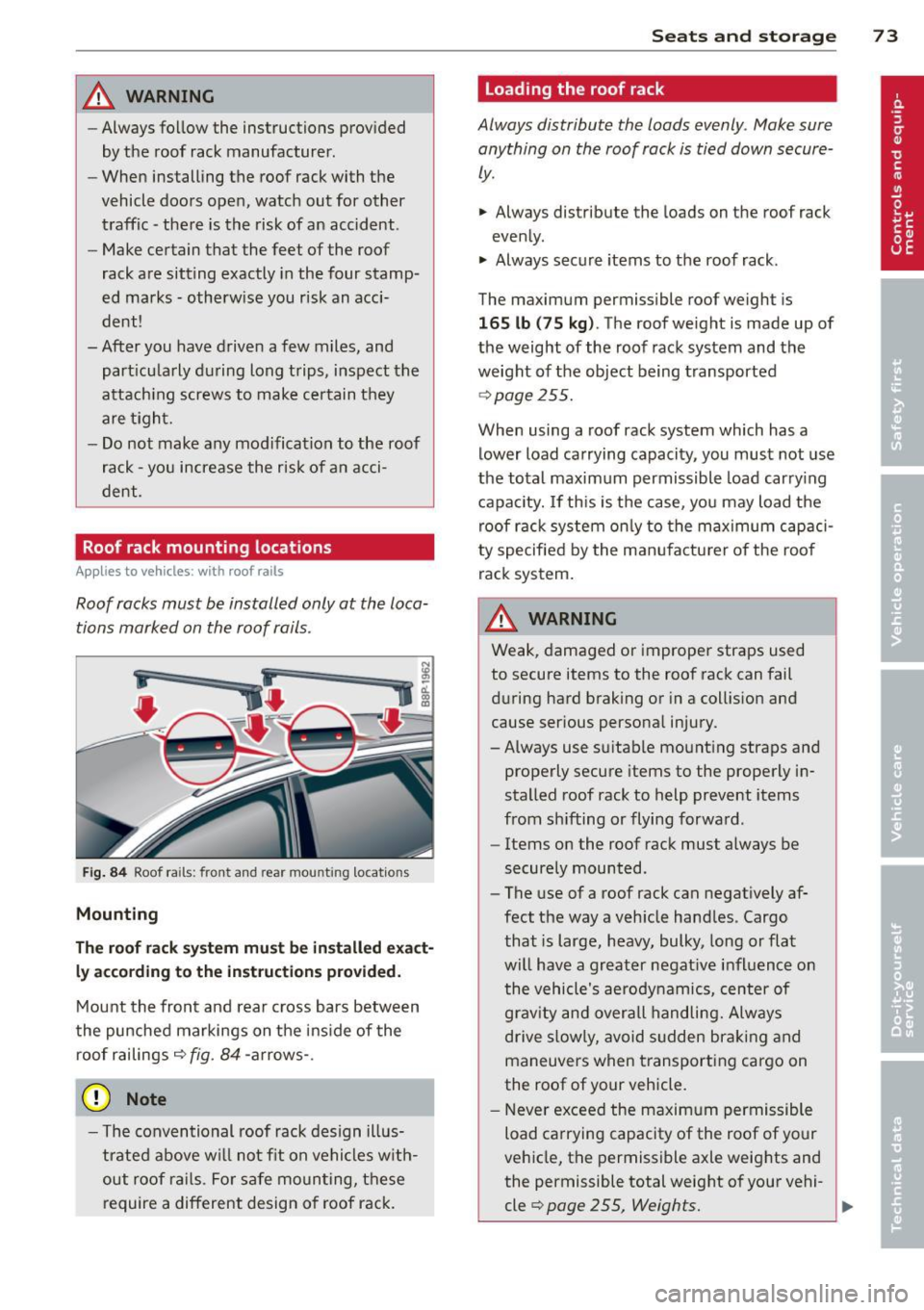
_& WARNING
-Always follow the instructions prov ided
by the roof rack manufacturer.
- When installing the roof rack with the
vehicle doors open, watch out for other
traffic - there is the risk of an accident .
- Make certain that the feet of the roof
rack are sitting exactly in the four stamp
ed marks - otherw ise you risk an acci
dent!
- After you have driven a few miles, and part icularly during long trips, inspect the
attach ing screws to make certain they
are tight.
- Do not make any modification to the roof
rack - you increase the risk of an acci
dent.
Roof rack mounting locations
App lies to vehicles: with roof rails
Roof racks must be installed only at the Loca
tions marked on the roof rails .
Fig . 8 4 Roof ra ils: front and rear mou nting locations
Mounting
The roo f rack syste m mu st be in sta ll ed exact
l y accord ing to th e instru cti ons prov ided.
Mount the front and rear cross bars between
the punched markings on the ins ide of the
roof railings
r::;,fig. 84-arrows- .
(D Note
- The conventional roof rack des ign illus
trated above w il l not f it on vehicles w ith
out roof ra ils. For s afe mounting, these
require a different design of roof rack.
S ea ts a nd s to rage 73
Loading the roof rack
Always distribute the Loads evenly . Make sure
anything on the roof rack is tied down secure
ly.
.. Always distribute the loads on the roof rack
evenly.
.. Always secure items to the roof rack.
The maximum permissible roof weight is
16 5 lb (75 k g). The roof weight is made up of
the weight of the roof rack system and the
weight of the object being transported
.;, page 255.
When using a roof rack system which has a
lower load carrying capacity, you must not use
the total maximum permissible load carry ing
capacity. If th is is the case, you may load the
roof rack system on ly to the maximum capaci
ty specified by the manufacturer of the roof
rack system.
A WARNING
Weak, damaged or improper straps used
to secure items to the roof rack can fail
during hard braking or in a coll is ion and
cause ser ious persona l injury.
-Always use suitable mounting straps and
properly secure items to the properly in
stalled roof rack to help prevent items
from sh ifting or flying forward .
- Items on the roof rack must always be
securely mounted.
- The use of a roof rack can negat ively af
fect the way a veh icle hand les . Cargo
that is large, heavy, bulky, long or flat
will have a greater negat ive influence on
the vehicle's aerodynamics, center of
grav ity and overa ll handling. Always
drive s lowly, avoid sudden braki ng and
maneuvers when transporting cargo on
the roof of your vehicle.
- Never exceed the maxim um permissible
load carrying capacity of the roof of your
vehicle, the permissible axle weights and
the permissible total weight of your vehi- cle
r::;, page 255, Weights. ~
Page 78 of 280

76 Seats and storage
& WARNING
-Always remove objects from the instru
ment panel. Any items not put away
could slide around inside the vehicle
while driving or when accelerating or
when applying the brakes or when driv
ing around a corner.
- When you are driving make sure that
anything you may have placed in the cen
ter console or other storage locations
cannot fall out into the footwells. In case
of sudden braking you would not be able
to brake, depress the clutch or acceler
ate.
- Any pieces of clothing that you have
hung up must not interfere with the driv
er's view. The coat hooks are designed
only for lightweight clothing. Never hang
any clothing with hard, pointed or heavy
objects in the pockets on the coat hooks.
During sudden braking or in an accident -
especially if the airbag is deployed -
these objects could injure any passen
gers inside the vehicle .
Glove compartment
The glove compartment is illuminated and
can be locked .
Fig. 89 Glove compar tment
To open glove compartment
"' Pull the handle~ fig. 89 in the direct ion of
the arrow push down lid to th e fully op en
position.
1 ) Not ava ilab le o n veh icl es with Audi N avigat ion Sys
t e m .
To close glove compartment
"' Push the glove compartment lid upward un-
til the lock engages.
The light will illuminate when the parking/
headlights are turned on and the glove com
partment is open.
In the glove compartment lid, you will find a
place to store a pen and a pad of paper .
In the glove compartment, you will find the
CD-changer* for navigation system* . A sepa
rate Owner's Manual is in vehicles that have a
factory-installed CD changer and navigation
system.
A WARNING
To reduce the risk of personal injury in an
accident or sudden stop, always keep the
glove compartment closed while driving.
Ga Storage compartment for small
objects
Applies to vehicles: with storage compartment in center
console
Fig. 90 Cen te r c onso le s torage compar tme nt
"' To open the compartment, press the cover
Cg ~fig. 90.
-
"' To close the compartment, push the drawer
all the way in until it clicks in place.
An additional storage compartment
1> for rela
tively small objects is located in the center
console next to the brake lever.
Page 80 of 280
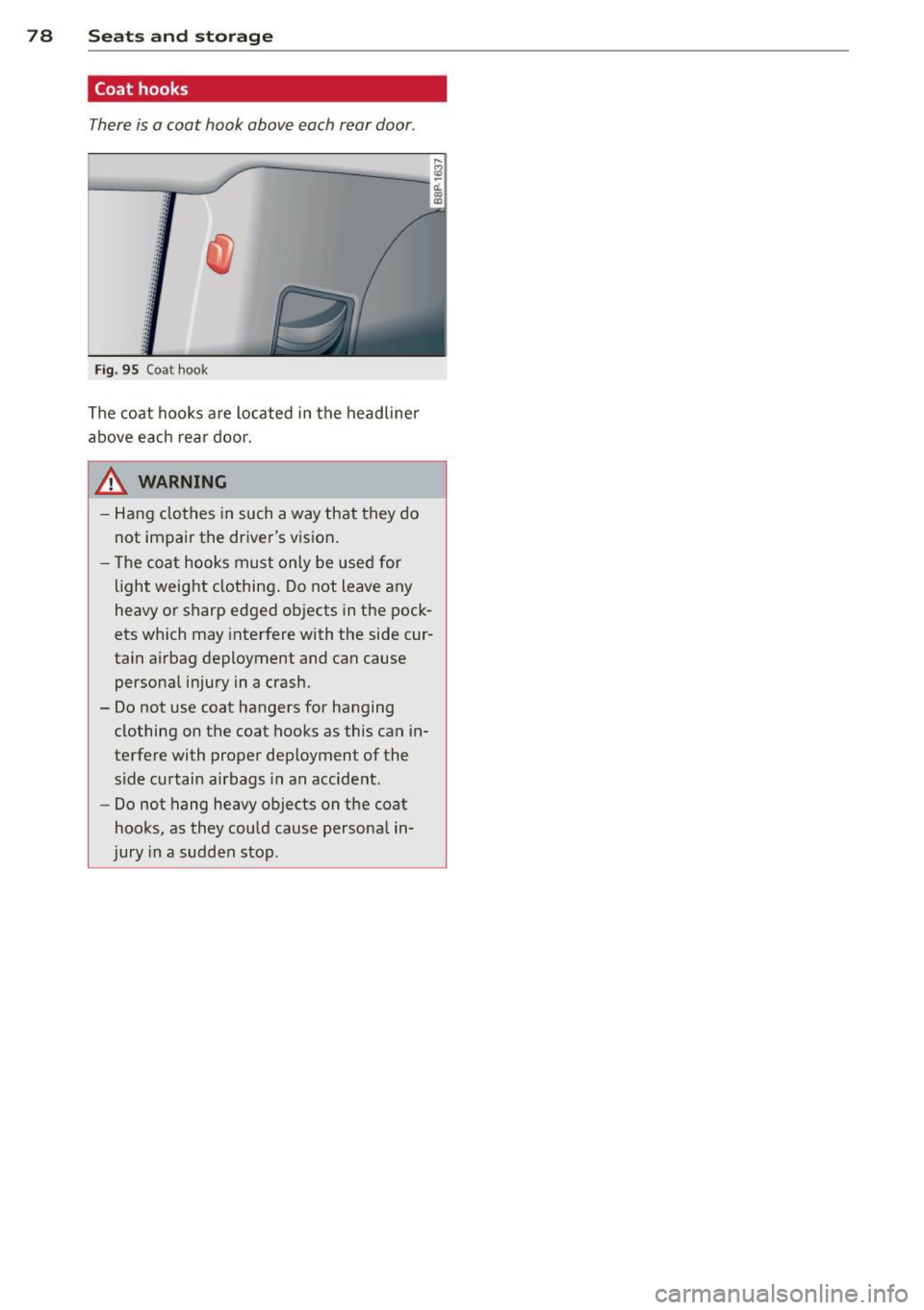
78 Seats and storage
Coat hooks
There is a coat hook above each rear door .
.. ., ' . 'I ., '
Fi g. 9 5 Coa t hook
The coat hooks are located in the headliner
above each rear door.
A WARNING
- Hang clothes in such a way that they do
not impair the driver's vision .
- Th e coat hooks must only be use d for
ligh t weight clothing . Do not leave any
heavy or sharp edged objects in the pock
ets which may interfere with the side cur
tain airbag deployment and can cause
perso na l injury in a cras h.
- Do not use coat hangers for hanging clothing on the coat hooks as this can in
terfere with proper deployment of the side curtain airbags in an accident.
- Do not hang heavy objects on t he coat
hooks, as they could cause persona l in
jury in a sudden stop.
Page 111 of 280
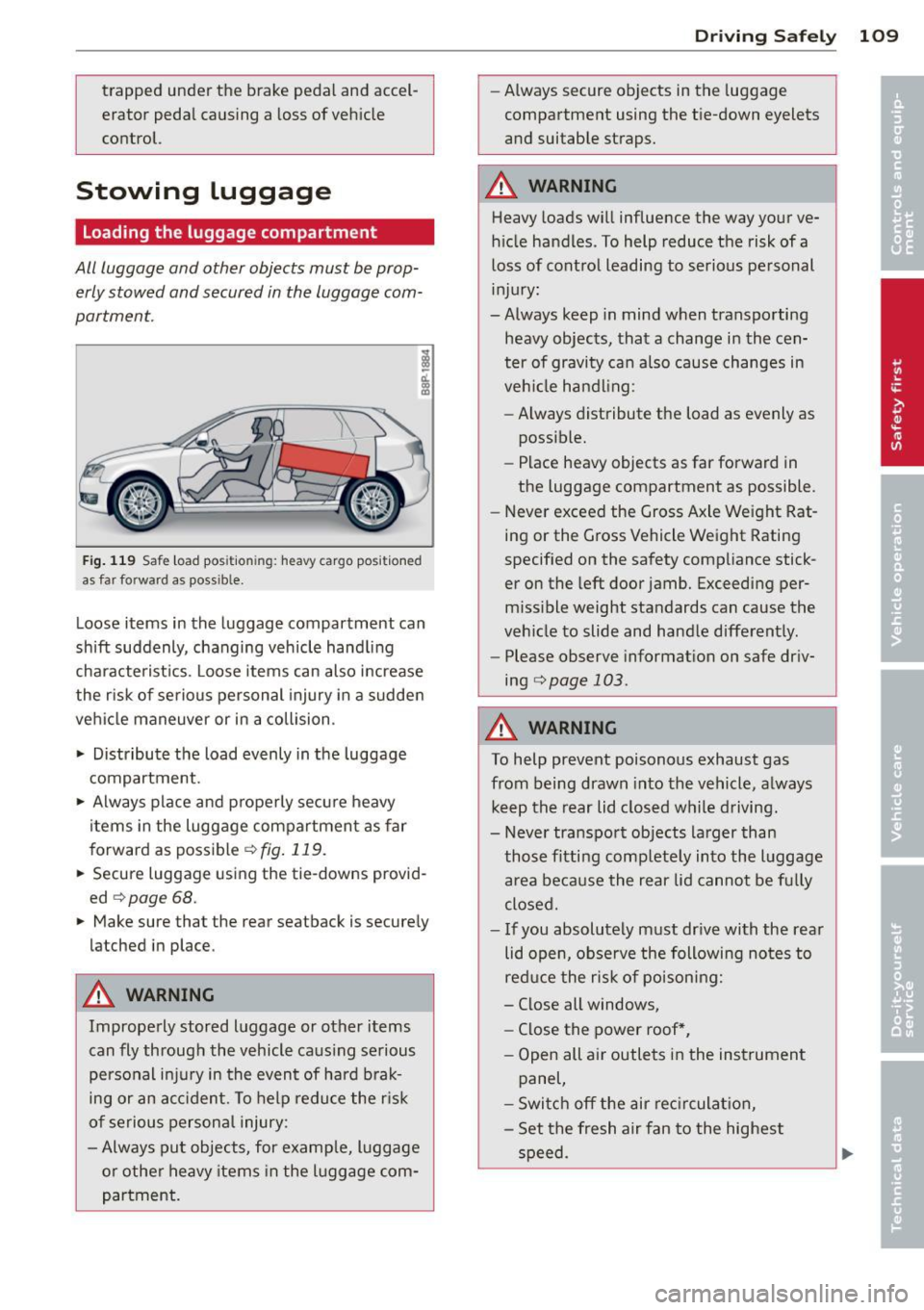
trapped under the brake pedal and accel
erator pedal causing a loss of vehicle
control.
Stowing luggage
Loading the luggage compartment
All luggage and other objects must be prop
erly stowed and secured in the luggage com
partment.
F ig . 119 Safe load position ing: heavy cargo positioned
as far forward as poss ib le.
Loose items in the luggage compartment can
shift suddenly, changing vehicle handling
characterist ics. Loose items can also increase
the r isk of serio us personal injury in a sudden
vehicle maneuver or in a collision .
.,. Distribute the load evenly in the luggage
compartment .
.,. Always place and properly secure heavy
items in the luggage compartment as far
forward as poss ible
¢ fig . 119.
.,. Secure luggage using the tie-downs provid
ed
¢ page 68.
.,. Make sure that the rear seatback is secure ly
latched in place.
A WARNING
Improperly stored luggage or other items
can fly through the vehicle caus ing se rious
personal injury in the event of hard b rak
ing or an ac cident. To help redu ce the r isk
o f serious persona l injury:
- Always put objects, for examp le, luggage
or other heavy items in the l uggage com
partment.
Dr ivin g Sa fely 109
-Always secure objects in the luggage
compartment using the t ie-down eyelets
and suitable straps.
A WARNING
Heavy loads w ill influence the way your ve
hicle handles. To help reduce the risk of a
loss of control leading to serious personal
injury:
-Always keep in mind when transporting
heavy objects, that a change in the cen
ter of gravity can also cause changes in
veh icle hand ling:
- Always distribute the load as evenly as
possible.
- Place heavy objects as far forward in
the luggage compartment as possible.
- Never exceed the Gross Axle We ight Rat
ing or the G ross Vehicle Weight Rating
specif ied on the safety compliance stick
er on the left door jamb. Exceeding per
miss ible weight standards can cause the
veh icle to slide and handle different ly.
- Please
observe informat ion on safe driv
ing¢
page 103.
A WARNING
To help prevent poisonous exhaust gas
from being drawn into the vehicle, always
ke ep the rear lid clos ed w hile driving.
- Never transport objects larger than
those fitting completely into the luggage area because the rear lid cannot be fu lly
closed .
- I f you absolutely must dr ive with the rea r
lid open, o bserve the following no tes to
red uce the risk of poison ing:
- Close all windows,
- Close the power roof*,
- Open all air outlets in the instrument
panel,
- Swi tc h off the air rec irculat ion,
- Set the fresh air fan to the highest
speed.
Page 112 of 280
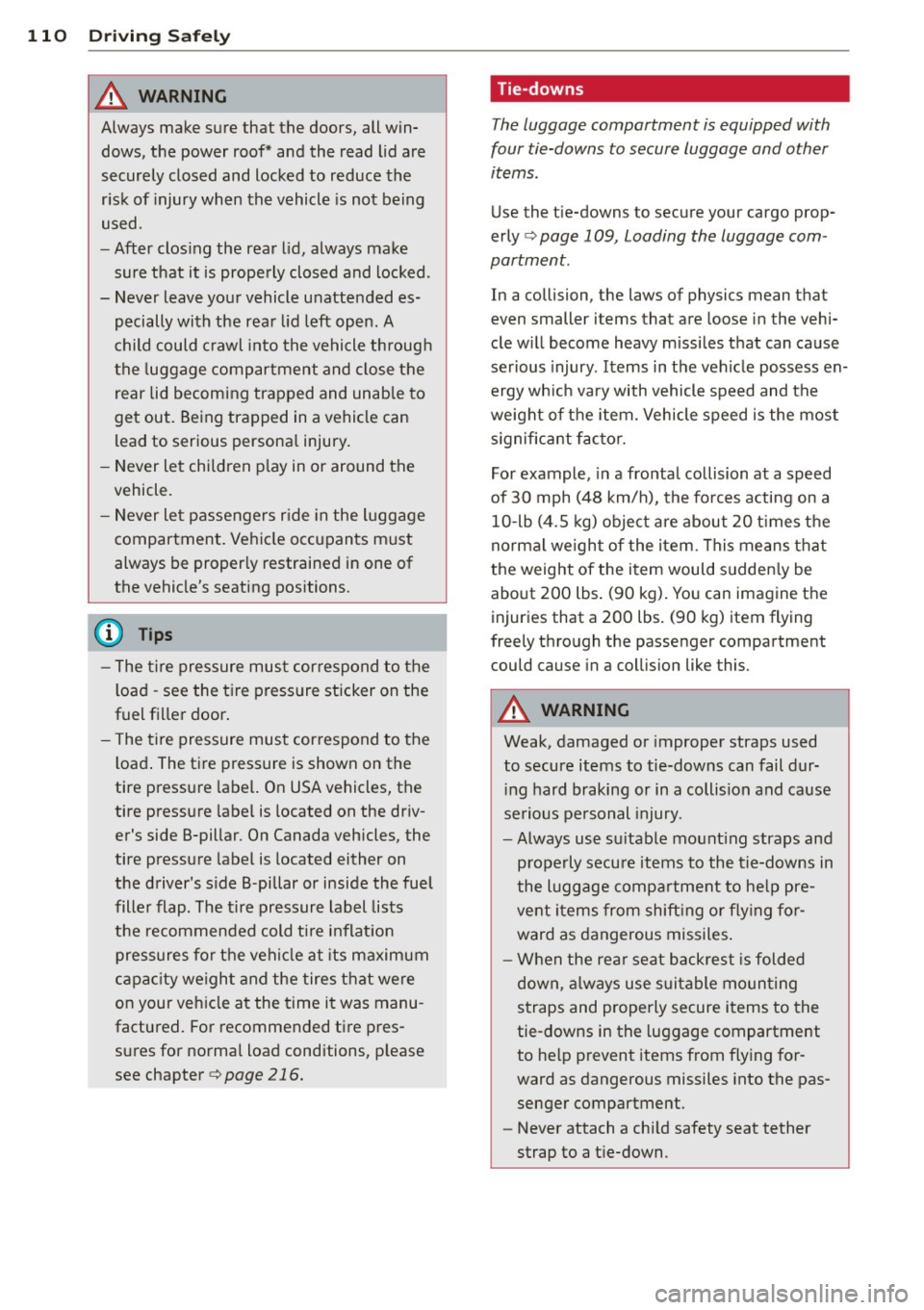
110 Driving Safely
&_ WARNING
Always make sure that the doors, all windows, the power roof* and the read lid are
securely closed and locked to reduce the
risk of injury when the vehicle is not being
used.
-After closing the rear lid, always make
sure that it is properly closed and locked.
- Never leave your vehicle unattended es
pecially with the rear lid left open. A
child could crawl into the vehicle through
the luggage compartment and close the
rear lid becoming trapped and unable to
get out. Being trapped in a vehicle can
lead to serious personal injury.
- Never let children play in or around the
vehicle.
- Never let passengers ride in the luggage
compartment. Vehicle occupants must
always be properly restrained in one of
the vehicle's seating positions.
(D Tips
- The tire pressure must correspond to the
load -see the tire pressure sticker on the
fuel filler door.
- The tire pressure must correspond to the
load. The tire pressure is shown on the
tire pressure label. On USA vehicles, the
tire pressure label is located on the driv
er's side B-pillar. On Canada vehicles, the
tire pressure label is located either on
the driver's side B-pillar or inside the fuel
filler flap. The tire pressure label lists
the recommended cold tire inflation pressures for the vehicle at its maximum
capacity weight and the tires that were
on your vehicle at the time it was manu
factured. For recommended tire pres
sures for normal load conditions, please
see chapter ¢
page 216.
-
Tie-downs
The luggage compartment is equipped with
four tie-downs to secure luggage and other
items.
Use the tie-downs to secure your cargo prop
erly
¢ page 109, Loading the luggage com
partment .
In a collision, the laws of physics mean that
even smaller items that are loose in the vehi
cle will become heavy missiles that can cause
serious injury. Items in the vehicle possess en
ergy which vary with vehicle speed and the
weight of the item. Vehicle speed is the most
significant factor.
For example, in a frontal collision at a speed
of 30 mph (48 km/h), the forces acting on a 10-lb (4.5 kg) object are about 20 times the
normal weight of the item . This means that
the weight of the item would suddenly be
about 200 lbs. (90 kg). You can imagine the
injuries that a 200 lbs. (90 kg) item flying
freely through the passenger compartment
could cause in a collision like this.
&_ WARNING ~
Weak, damaged or improper straps used
to secure items to tie-downs can fail dur
ing hard braking or in a collision and cause
serious personal injury.
-Always use suitable mounting straps and
properly secure items to the tie-downs in
the luggage compartment to help pre
vent items from shifting or flying for ward as dangerous missiles.
- When the rear seat backrest is folded
down, always use suitable mounting
straps and properly secure items to the
tie-downs in the luggage compartment
to help prevent items from flying for
ward as dangerous missiles into the pas
senger compartment .
- Never attach a child safety seat tether
strap to a tie-down.
Page 116 of 280
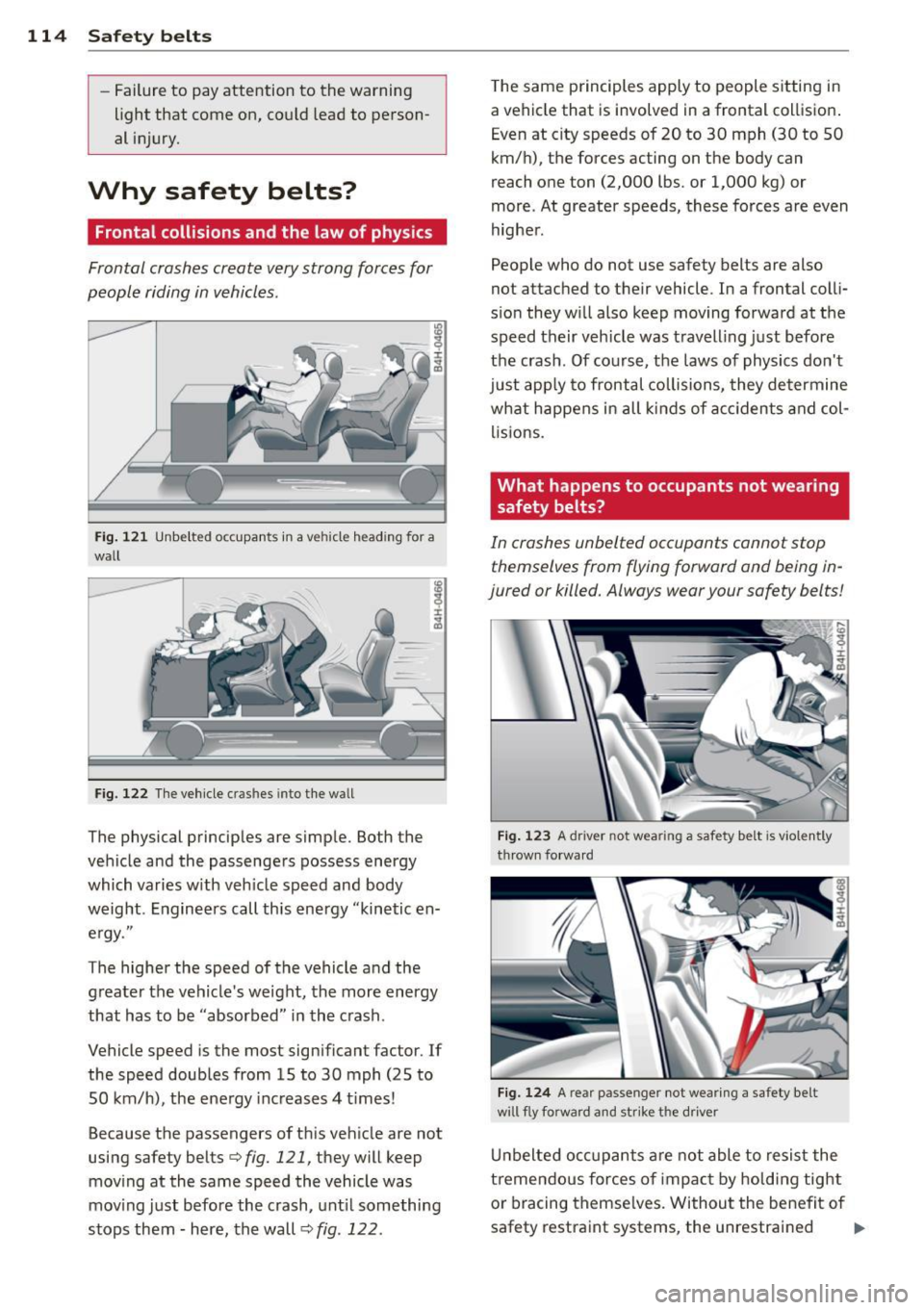
114 Safety belts
-Failure to pay attention to the warning
light that come on, could lead to person
al injury.
Why safety belts?
Frontal collisions and the law of physics
Frontal crashes create very strong forces for
people riding in vehicles.
Fig. 121 Unb elted occupants in a ve hicle heading for a
wall
Fig. 122 Th e vehicle c rash es into the wall
The physical principles are simple. Both the
vehicle and the passengers possess energy
which varies w ith veh icle speed and body
weight . Engineers call this energy "kinetic en
e rgy ."
T he higher the speed of the vehicle and the
greater the vehicle's weight, the more energy
that has to be "absorbed" in the crash .
Vehicle speed is the most significant factor.
If
the speed doubles from 15 to 30 mph (25 to
50 km/h), the energy increases 4 times!
Because the passengers of this vehicle are not
using safety belts
c::;, fig. 121, they will keep
moving at the same speed the vehicle was
mov ing just before the crash, until something
stops them - here, the wall ¢
fig. 122 .
The same principles apply to people sitting in
a vehicle that is involved in a frontal collision .
Even at city speeds of 20 to 30 mph (30 to 50
km/h), the forces acting on the body can
reach one ton (2,000 lbs. or 1,000 kg) or
more . At greater speeds, these forces are even
higher .
Peop le who do not use safety belts are also
not attached to their vehicle. In a frontal colli
s ion they will also keep moving forward at the
speed their vehicle was travell ing just before
the crash . Of course, the laws of physics don't
just apply to frontal collisions, they determine
what happens in all kinds of accidents and col
lisions .
What happens to occupants not wearing
safety belts?
In crashes unbelted occupants cannot stop
themselves from flying forward and being in
jured or killed. Always wear your safety belts!
Fig. 123 A d river not wea ring a safety b elt is viol en tly
thrown fo rwa rd
Fig . 124 A rear passe nge r not wearing a safety belt
w ill fl y forward and strike the dr iver
Unbelted occupants are not able to resist the
tremendous forces of i mpac t by holding tight
or bracing themselves. Without the benefit of
safety restraint systems , the unrestrained
ll-
Page 126 of 280
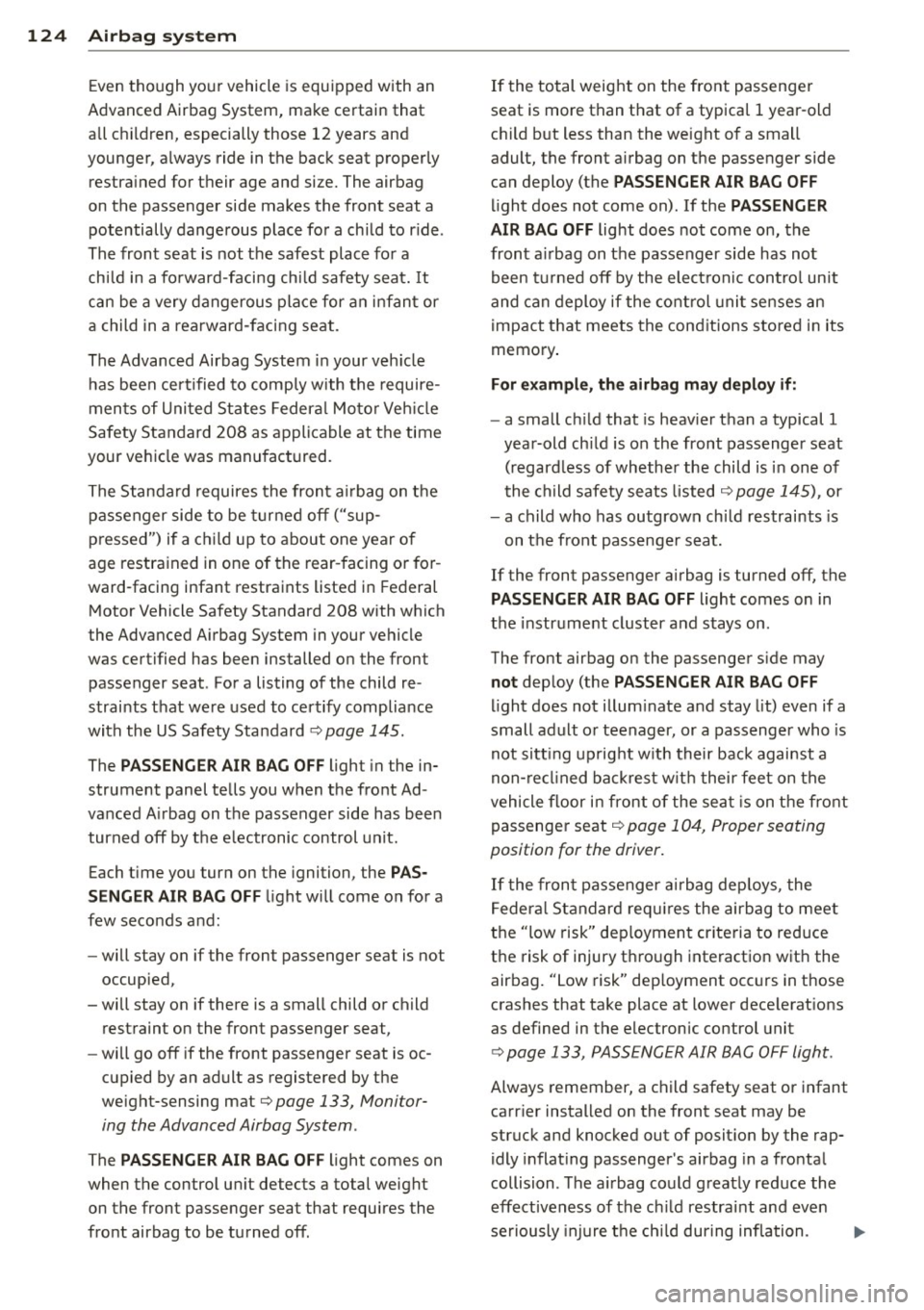
124 Airbag system
Even though your vehicle is equipped with an
Advanced Airbag System, make certain that
all chi ldren, especially those 12 years and
younger, a lways ride in the back seat properly
restrained for their age and size. The airbag
on the passenger side makes the front seat a potentially dangerous place for a ch ild to ride.
The front seat is not the safest place for a
child in a forward-facing child safety seat. It
can be a very dangerous place for an infant or
a child in a rearward-facing seat.
The Advanced Airbag System in your veh icle
has been certified to comply with the require
ments of United States Federal Motor Vehicle
Safety Standard 208 as applicable at the time
your vehicle was manufactured.
The Standard requires the front a irbag on the
passenger side to be turned off ("sup
pressed") if a child up to about one year of
age restrained in one of the rear-facing or for
ward -facing infant restraints listed in Federal
Motor Vehicle Safety Standard 208 with which
the Advanced Airbag System in your vehicle
was certified has been installed on the front passenger seat . For a listing of the child re
strai nts that we re used to certify compliance
with the US Safety Standard
r=v page 145.
The PASSENGER AIR BAG OFF light in the in
strument panel te lls you when the front Ad
vanced A irbag on the passenger side has been
turned off by the e lectronic control unit.
Each t ime you turn on the ignition, the
PAS
SENGER AIR BAG OFF
light will come on for a
few seconds and:
- will stay on if the front passenger seat is not
occupied,
- will stay on if there is a small child or child restraint on the front passenger seat,
- wi ll go off if the front passenger seat is oc
cupied by an adult as registered by the
weight-sensing mat
r=v page 133, Monitor
ing the Advanced Airbag System .
The PASSENGER AIR BAG OFF light comes on
when the control un it detects a total weight
on the front passenger seat that requires the
front airbag to be turned off.
If the total weight on the front passenge r
seat is more than that of a typica l 1 year -old
chi ld but less than the weight of a small
adult, the front airbag on the passenger side
can deploy (the
PASSENGER AIR BAG OFF
light does not come on). If the PASSENGER
AIR BAG OFF
light does not come on, the
front airbag on the passenger side has not
been turned off by the electronic con trol unit
and can deploy if the control unit senses an
impact that meets the cond itions stored in its
memory .
For example, the airbag may deploy if:
-a small ch ild that is heav ier than a typical 1
year-old ch ild is on the front passenger seat
( re gard less of whether the child is in one of
the child safety seats listed
r=v page 145), or
- a child who has outgrown ch ild restraints is
on the front passenger seat.
If the front passenger airbag is turned off, the
PASSENGER AIR BAG OFF light comes on in
the instrument cluster and stays on.
The front airbag on the passenger s ide may
not deploy (the PASSENGER AIR BAG OFF
light does not illum inate and stay lit) even if a
small adult or teenager, or a passenger who is
not sitting upright with their back against a
non-reclined backrest with their feet on the
vehicle floor in front of the seat is on the front
passenger seat
r=v page 104, Proper seating
position for the driver.
If the front passenger airbag deploys, the
Federal Standard requires the airbag to meet
the "low risk" deployment criteria to reduce
the risk of injury t hroug h interaction with the
airbag. "Low risk" deployment occurs in those
crashes that take place at lower dece lerat ions
as defined in the electronic control unit
r=v page 133, PASSENGER AIR BAG OFF light .
Always remember, a child safety seat or infant
carr ier installed on the front seat may be
struck and knocked out of posit ion by the rap
idly inflat ing passenger's airbag in a frontal
collision . The air bag could greatly reduce the
effectiveness of the ch ild restraint and even
seriously injure the child during inflation .